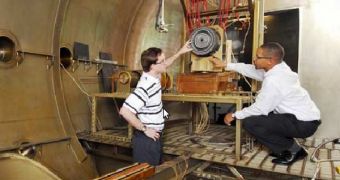The vast distances in the Universe constitute the main obstacles in devising and sending out space missions to other stars or planetary systems. Until mankind would have a permanent base on the Moon, from where to send out space explorers, we are doomed to have to launch all probes on rockets that burn massive amounts of fuel. When they reach orbit, space probes then have to rely on their own internal power source. This is all well and good, until they have to travel very long distances.
Chemical-powered engines have long since been abandoned in favor of solar-powered ones. There were several proposals that sought to take nuclear power to orbit as well. These ideas have not disappeared entirely. A nuclear-powered mission is envisioned for the moon Titan, with another Russian spacecraft powered in the same way recently scheduled for launch in 2012. But the most promising method of propulsion is by far the ion thruster, which has already proven its worth on several missions.
However, as we have also reported recently, these engines too have their limitations. The Japanese Hayabusa sample-return probe is currently running on a single, damaged ion thruster, out of the four it originally had. Voltage spikes claimed the “lives” of the others. But new generations of the instruments, currently in the works in Japan and the United States primarily, could overcome these drawbacks, and become the norm in space propulsion. These engines work by expelling ionized gas at high speeds, which generates thrust. They usually burn up xenon gas, although other fuels are also possible.
The new generation of ion engines, scientists say, will harvest vital electrons straight from electrified carbon nanotubes (CNT), rather than from xenon gas. A good ion engine “can add an extra year of life to a satellite. That's not inconsiderable for a satellite that lasts 10 years or less,” Georgia Institute of Technology (Georgia Tech) materials engineer Jud Ready explains. The university was awarded a $6.5-million grant from the US Defense Advanced Research Projects Agency (DARPA), to come up with better variants of the ion thruster.
“The current design relies on servomotors and joints, but each one is a possible failure point. There are no moving parts with the non-mechanical way, and you get the same impact,” Georgia Tech aerospace engineer Mitchell Walker says. He is also the lead investigator of the new project, which could see an experimental spacecraft sporting the new engines lifting to orbit as soon as 2015, Space reports.

 14 DAY TRIAL //
14 DAY TRIAL //